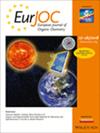Morita - Baylis - Hillman反应中喹啉盐的C4 -区域选择性脱芳化
IF 2.7
3区 化学
Q2 CHEMISTRY, ORGANIC
引用次数: 0
摘要
以N -苄基喹啉盐为亲电试剂,建立了分子间Morita - Baylis - Hillman反应。该反应通过对喹啉的C4选择性去芳化进行,这与我们之前在类似过程中观察到的C2区域选择性相反。区域选择性的切换是通过改变喹啉盐中的反离子为PF6 -和改变反应条件(如使用不同的催化剂(DABCO))来实现的。该反应允许制备具有重要的1,4‐二氢喹啉支架的富官能团产物,补充了先前提供相应的1,2‐二氢喹啉对应物的方法。开发的反应是相容的底物范围,也包括吖啶盐。本文章由计算机程序翻译,如有差异,请以英文原文为准。
C4‐Regioselective Dearomatization of Quinolinium Salts via Morita‐Baylis‐Hillman Reaction
An intermolecular Morita‐Baylis‐Hillman reaction employing N‐benzylquinolinium salts as electrophiles was developed. The reaction proceeds through a C4‐selective dearomatization of the quinolinium substrate, contrary to the C2‐regioselectivity that was observed in our previous report on a similar process. The switch in the regioselectivity was accomplished through the change of the counterion in the quinolinium salt to PF6– and the alteration of the reaction conditions, such as the application of a different catalyst (DABCO). The reaction allows for the preparation of functional group‐rich products featuring the important 1,4‐dihydroquinoline scaffold, complementing the earlier method which provides the corresponding 1,2‐dihydroquinoline counterparts. The developed reaction is compatible with a range of substrates that also encompasses acridinium salts.
求助全文
通过发布文献求助,成功后即可免费获取论文全文。
去求助
来源期刊
CiteScore
5.40
自引率
3.60%
发文量
752
审稿时长
1 months
期刊介绍:
The European Journal of Organic Chemistry (2019 ISI Impact Factor 2.889) publishes Full Papers, Communications, and Minireviews from the entire spectrum of synthetic organic, bioorganic and physical-organic chemistry. It is published on behalf of Chemistry Europe, an association of 16 European chemical societies.
The following journals have been merged to form two leading journals, the European Journal of Organic Chemistry and the European Journal of Inorganic Chemistry:
Liebigs Annalen
Bulletin des Sociétés Chimiques Belges
Bulletin de la Société Chimique de France
Gazzetta Chimica Italiana
Recueil des Travaux Chimiques des Pays-Bas
Anales de Química
Chimika Chronika
Revista Portuguesa de Química
ACH—Models in Chemistry
Polish Journal of Chemistry.

 求助内容:
求助内容: 应助结果提醒方式:
应助结果提醒方式:


